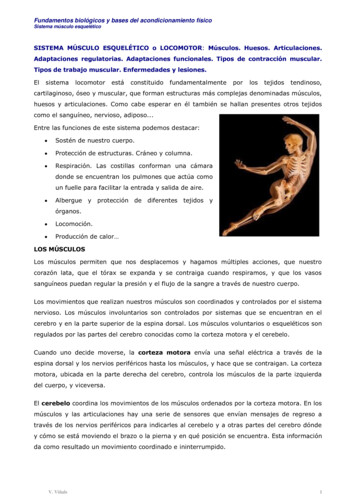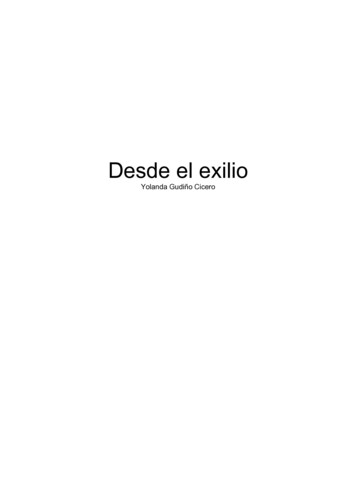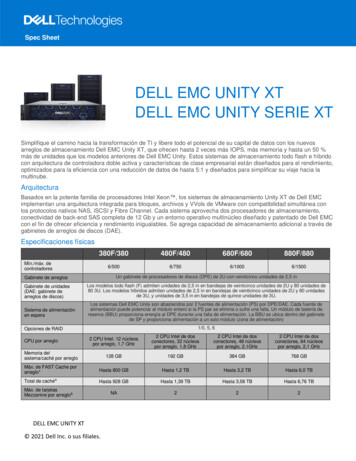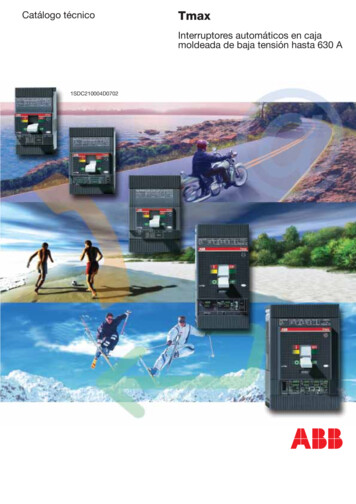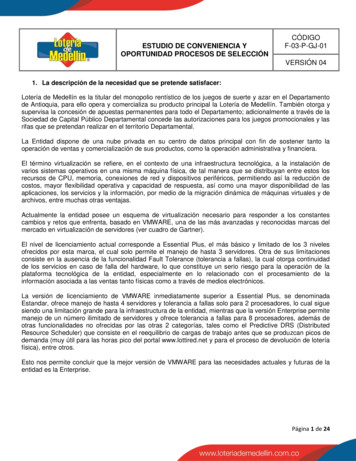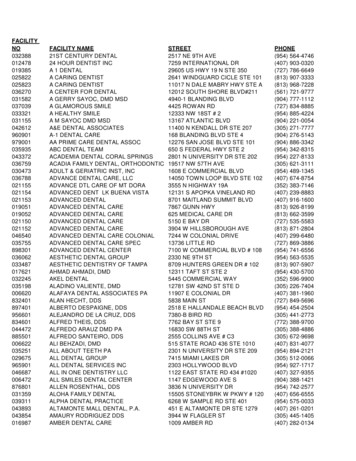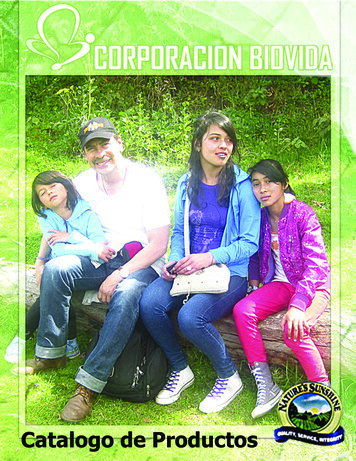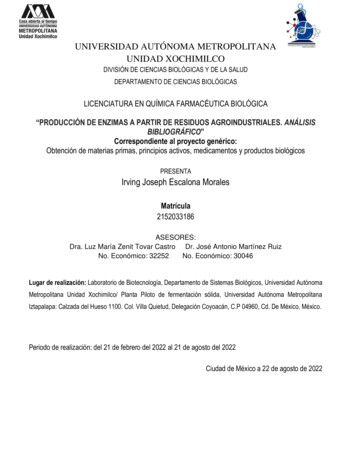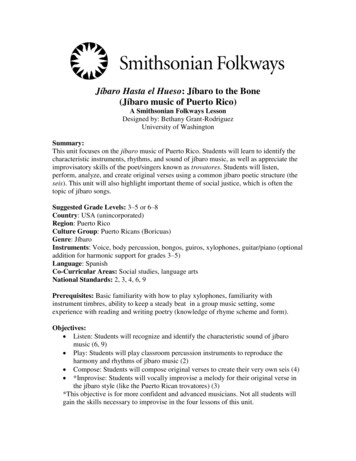
Transcription
Jíbaro Hasta el Hueso: Jíbaro to the Bone(Jíbaro music of Puerto Rico)A Smithsonian Folkways LessonDesigned by: Bethany Grant-RodriguezUniversity of WashingtonSummary:This unit focuses on the jíbaro music of Puerto Rico. Students will learn to identify thecharacteristic instruments, rhythms, and sound of jíbaro music, as well as appreciate theimprovisatory skills of the poet/singers known as trovatores. Students will listen,perform, analyze, and create original verses using a common jíbaro poetic structure (theseis). This unit will also highlight important theme of social justice, which is often thetopic of jíbaro songs.Suggested Grade Levels: 3–5 or 6–8Country: USA (unincorporated)Region: Puerto RicoCulture Group: Puerto Ricans (Boricuas)Genre: JíbaroInstruments: Voice, body percussion, bongos, guiros, xylophones, guitar/piano (optionaladdition for harmonic support for grades 3–5)Language: SpanishCo-Curricular Areas: Social studies, language artsNational Standards: 2, 3, 4, 6, 9Prerequisites: Basic familiarity with how to play xylophones, familiarity withinstrument timbres, ability to keep a steady beat in a group music setting, someexperience with reading and writing poetry (knowledge of rhyme scheme and form).Objectives: Listen: Students will recognize and identify the characteristic sound of jíbaromusic (6, 9) Play: Students will play classroom percussion instruments to reproduce theharmony and rhythms of jíbaro music (2) Compose: Students will compose original verses to create their very own seis (4) *Improvise: Students will vocally improvise a melody for their original verse inthe jíbaro style (like the Puerto Rican trovatores) (3)*This objective is for more confident and advanced musicians. Not all students willgain the skills necessary to improvise in the four lessons of this unit.
Materials:Recordings:Puerto Rico in hsonianFolk Masters: Great Performances Recorded Live at the Barns of Wolf p/american-folk/music/album/smithsonianJíbaro Hasta el Hueso: Mountain Music of Puerto Rico by Ecos de -rico/latin-world/album/smithsonianVideos: (free downloads from iTunes U): Smithsonian Folkways Mexico, Central & South America videos Ecos deBorinquen demonstrate música jibara Smithsonian Folkways Mexico, Central & South America videos Ecos deBorinquen perform “Mujer Borinqueña”Instruments: Xylophones, guiros, bongos Optional: Guitar and/or piano (for the teacher to provide harmonic support to aidless musically advanced students)Visual Aids: Map of Puerto Rico (can be found by Google search) Photographs of Puerto Rican culture (flag, food, landscape, people, instruments;can be found by simple Google search, or display images from SmithsonianFolkways CD liner notes)Sound/Video/Technology: Ability to play specified audio and video recordings (sound system and videoprojector) Video projector and computer to display musical notation and poetic analysisLesson Segments:1. What Is Jíbaro? (National Standards 6, 9)2. Exploring Jíbaro Song Forms (National Standards 6, 9)3. Performing Jíbaro Music (National Standard 2)4. Creating an Original Jíbaro “Seis” (National Standards 2, 3, 4)
Lesson 1: What Is Jíbaro?a. Listening: “Seis Mapeyé” (track 108 from Puerto Rico in hsonian ); play only first 32 seconds ofpiece (end of “le le lei’s”) after posing the following questions.i. Ask: What instruments do you hear? (Strings—guitar and cuatro, aten-stringed lute used exclusively in Puerto Rican music; guiro,bongos.)ii. Ask: Did you hear anything repeat? How many times? (The entireintroduction repeats before the singer enters, so we hear it twotimes; bongo and guiro rhythm patterns are repetitive.)iii. Repeat listening to the recording as necessary to check studentanswers.b. Ask the following questions and then listen to the first 32 seconds of “SeisMapeyé” again.i. Ask: Is this song in a major or minor tonality? (Minor.)ii. Play the song again and ask: Can you sing the tonic? (Listen tohear if students sing the correct pitch— D.)iii. Play the song again and ask: Can you sing the bass line? What doyou notice? (It steps down—natural minor.)c. Listen to the 32-second clip again with the following questions in mind.i. Without hearing enough of the song to determine the language, canyou guess where the music comes from?” (Vocal line and syllablesmay sound Arabic; this is the Arabic influence that came to PuertoRico through the Spanish. Lead students to discover it comes fromPuerto Rico.)ii. How do you know that? What clues did you get? (Instruments—strings/guitar, guiro, and bongos; rhythms common to Puerto Ricanmusic; tonality and chord progressions also commonly used.)d. Provide students with cultural information:i. Ask students to find Puerto Rico on a world map. Discuss itslocation in the Caribbean.ii. Report on its history as a Spanish colony (claimed for Spain byChristopher Columbus on his second voyage in November 1493)and now as a territory of the United States (ceded to the UnitedStates from Spain in 1898 after the Spanish-American War; PuertoRicans became American citizens in 1917 around the time ofWWI, allowing the US army more potential soldiers; currentdebate in Puerto Rico is whether to remain a US colony, apply forstatehood, or secede and become an independent nation). Tellstudents that in the same way that Native Americans were in theUnited States before Europeans arrived, the Taíno people lived inPuerto Rico. They were briefly enslaved by Spanish settlers, butdue to outbreaks of infectious diseases that killed many of them,they were officially emancipated in 1520. African slaves were thenbrought to Puerto Rico by the Spanish to do the work the Taíno
iii.iv.v.vi.vii.had been forced to do. Over the years, the Spanish settlers, Africanslaves, and Taíno residents converged to form what is now theBoriuca people and culture. The word boriqua comes fromBoriquén, the name the Taíno people used to refer to the island ofPuerto Rico.Show photographs of Puerto Rican people, food, dress, geography(rainforest, beaches, farms, etc.). These can be found online or inthe liner notes of the three Smithsonian Folkways CDs used in thislesson.Inform the students that the music they just heard was the music ofthe rural people; it was born on farms and in the mountains of thePuerto Rican countryside. Introduce the term jíbaro for the style ofmusic.Due to the resurgence of cultural and racial pride in the UnitedStates during the 1960s and 1970s, jíbaro music experienced a timeof growth and popularization. Fueled by a parallel movement inPuerto Rico, jíbaro music (and other Puerto Rican roots music)enjoyed a renaissance supported in large part by governmentprograms through the Institute of Puerto Rican Culture.Ask: Where you can find jíbaro music today? (Everywhere! It isidentified as the music of Puerto Rico that unites all the regions ofthe island and people of Puerto Rican descent in other parts of theworld as well). For further information, see liner notes of PuertoRico in ner notes/smithsonian folkways/SFW40460.pdf ) and Jíbaro Hasta el Hueso(http://media.smithsonianfolkways.org/liner notes/smithsonian folkways/SFW40506.pdf ).Show pictures of instruments used in jíbaro (cuatro, guitar, guiro,bongos) and discuss each one. Emphasize the cuatro; it is thesound and virtuosic playing of the cuatro that differentiates jíbaromusic from other Puerto Rican and Latin American musics.Cuatro
e. Ask: Can you air play the instruments? Listen for each differentinstrument and air play it as I point to its picture. Play same 32-secondmusical clip again, pointing to a different instrument every eight secondsor so.f. Ask: Can you sing/hum/vocalize each instrument’s part as I point to itspicture? Play the clip and point to one instrument each time. Repeat foreach instrument. More than one listening may be required for students tohear certain parts; repeat as necessary until you can discern that moststudents are closely approximating the part of the instrument you arepointing to. Teacher modeling may be necessary if students cannot hearthe parts themselves (consult transcription in lesson 3). For the guitar part,have the students sing the root of each chord (bass line).i. Bongo and guiro parts can be transferred to body percussion. Letstudents creatively use their bodies to play the rhythms they hear.ii. Try combining two or three instrument parts at once (point tomultiple pictures at once).iii. Allow students to choose which instrument they want to “play”and then all vocalize or use body percussion together with therecording.g. Optional extension: “Play” the music without the recording. Each studentchooses one of the instrument parts, and they all perform their chosenparts together, singing or performing body percussion. Go back and repeatthe previous step (performing with the recording) if necessary, and thentry to perform without the recording again.Assessment: Can students accurately perform parts of the song “Seis Mapeyé” by ear?Can they identify the different instrument timbres typical to jíbaro music? Can they recallcontextual information about jíbaro music (where it comes from, when it became popular,who listens to it today, etc.)?Lesson 2: Exploring Jíbaro Song Formsa. Review from the first lesson the following:i. This music comes from Puerto Ricoii. The musical genre is called jíbaroiii. The ten-stringed lute that is unique to jíbaro music is called acuatro. Although it is not a Spanish instrument, it was developed asa result of Spanish instruments (like the guitar) brought to PuertoRico in the 1600s.b. Tell the students that today they are going to learn about two differenttypes of jíbaro songs: the aguinaldo and the seis. Then play recording of“Aguinaldo Jíbaro” by Familia Colon, Folk Masters track americanfolk/music/album/smithsonian).
i.Tell students that this is an aguinaldo. It is the song form ofchoice for songs about the birth of Jesus, which is part of thePuerto Rican celebration of La Navidad (Christmas). Ask: Doyou have songs that you sing every year to celebrate Christmasor another special holiday with your family? (Various Christmascarols, other non-religious holiday songs like “Frosty theSnowman,” etc.)ii.Aguinaldos can also be about other topics, such as love orculturally specific values and traditions. These songs are fixedcompositions (notes and words do not change). This is onecharacteristic that distinguishes the aguinaldo from the othersong form we are going to study today, the seis.iii. Share other information from CD liner notes as applicable tohelping your students understand the aguinaldo song form(http://media.smithsonianfolkways.org/liner notes/smithsonian folkways/SFW40047.pdf ).c. Introduce another type of jíbaro song: seis.i.Originally a dance for six couples, hence the name seis, meaning“six.”ii.It has a ten-line poetic structure with a strict rhyming formulathat is often improvised by the trovador (singer/poet). Thisstructure and the fact that it is improvised are important factors indistinguishing the seis from the aguinaldo.iii.“Seis Mapeyé” is a seis (hence the title).iv.For more information on jíbaro song forms, including the seis,review the following liner notes from Jíbaro Hasta el Hueso(http://media.smithsonianfolkways.org/liner notes/smithsonian folkways/SFW40506.pdf).d. Watch video of Ecos de Borinquen: “Seis Chorreao” (downloaded fromiTunesU: Smithsonian Folkways Mexico, Central & South Americavideos Ecos de Borinquen demonstrate música jibara)i.Ask: What different instruments do you see? (Guitar, cuatro,guiro, female vocalist.)ii.Watch the video again and ask: Do you hear any musical phrasesbeing repeated? (Yes.) Do you hear any Spanish words thatrhyme? (Yes—see Appendix A; rhyme scheme will be addressedmore in Lesson 4.)iii. Tell students to raise their hands when they hear the cuatro solo(when the cuatro is playing or improvising a melody and issupported by the other instruments), and then play the videoagain, stopping after the cuatro solo concludes.iv.Ask the following question, and then play the video again: Doyou think she is singing a song someone taught her or is shemaking some parts up? How do you know? (She is making muchof it up as she goes along; the phrases sound similar to each other
but are somewhat different, limited pitch range, many repeatedpitches.)v.Ask: Does this song make you feel more happy or sad?(Although there is no right answer, the students are likely to findthat it sounds happy.) What features of the music make you feelthis way? (Fast notes, major tonality, she’s smiling while she’ssinging.) What do you think she’s singing about? (No rightanswer.)e. Ask the questions below one at a time, and then watch second video ofEcos de Borinquen: “Mujer Borinqueña” (downloaded from iTunesU:Smithsonian Folkways Mexico, Central & South America videos Ecosde Borinquen perform “Mujer Borinqueña”) after asking each question.i.Ask: The last song was in major. Is the next song in major orminor? (Minor tonality.)ii.Ask: Did the use of a minor tonality make you feel differentlywhen you listened to the song? (Some students may pick up onthe sadness or even anger in the song. Injustice is a commontheme in the seis song form and will be discussed more in thefourth lesson.)iii. Notice that in both videos there is an instrumental break thathighlights the cuatro solo (and gives the trovator an opportunityto think about the next verse he or she is going to improvise).The cuatro is the distinguishing instrument of jíbaro.Assessment: Students should be more familiar with the characteristic sounds and historyof jíbaro. Students should be able to identify seis as a type of jíbaro song.Lesson 3: Performing Jíbaro Musica. Play the first 32 seconds of “Seis Mapeyé.” Ask: Does any of this soundfamiliar? (Yes—this was the song from Lesson 1.) Ask: What kind ofsong is this? (Seis.)b. Review singing the bass line (D, C, Bb, A).c. Play the entire first verse (through 1:40). Display the Spanish lyrics(Appendix B) and ask: Can you follow the vocal line? Do you hear anypoetic phrases that repeat? (Yes—some of the words repeat: Hoytraigo un tema especial; la raza humana anda mal; si ante Dios somosiguales; el blanco y el de color)d. What do you think the singer is singing about? Does it sound happy orsad? (Variety of answers; sad.)e. Share the translation of the verse with the students, which is aboutracial injustice (see Appendix A).f. Point out to students that even though this is music of rural PuertoRicans, the themes that are representative of this music are themes
with which people from many different ethnicities and parts of theworld can identify. Give current examples (African Americans and thecivil rights movement in the United States, apartheid in South Africa,Native Americans and “Manifest Destiny,” caste system in India, Sunniand Shiite conflicts in many Middle Eastern countries). Ask students ifthey can identify with the singer. Have they ever seen or felt racialinjustice? Allow for students to share a few responses.g. Ask students to sing/play with body percussion any parts of the songthat they remember from Lesson 1 as we listen again (melody/vocalline, guiro part, bass line, chords, etc.), then play the recordingthrough verse one (stop at 1:40). Observe to see which students arecorrectly performing one of the parts.h. Add guiro part; perform with recording.i. Add bongo part; perform with recording and guiro.j. Add students playing bass line* on xylophone (teacher may play onguitar); perform with recording.
k. Play introduction (the introduction is the first four measures of thepiece repeated—see transcription above) along with recording.l. Play introduction without recording.* The part can also be simplified in the fourth measure by having students play therhythm that is written but stay on the A instead of playing the moving sixteenthnotes. It is helpful for the teacher to reinforce the harmony by playing the chords onthe guitar or piano if students are only able to play the bass line.Extension (optional): More advanced groups could play the entire chord onxylophones:a. Some students play the xylophone rhythm on the 3rd of each chord (ex. Fin measure 1).b. Other students play the xylophone rhythm on the 5th of the chord (ex. A inmeasure 1).c. In measures 3 and 4, add the 7th (Ab in measure 3 and Bb in measure 4)so that the entire chord sounds instead of just the bass line.Assessment: Can the students play the piece accurately with the recording? Can theyplay without the recording? Can they identify ways their performance either does or doesnot sound like the original performance?Lesson 4: Creating Original “Seis” Versesa. Listen to verse one (through 1:40) of “Seis Mapeyé,” track 8 on PuertoRico in Washington i. Review the seis as a song form (see liner notes for CD PuertoRico in Washington for a description of the history andcommon form/rhyme scheme of the seis).ii. Also note the common use of improvisation in the singing ofthe seis, as well as the repetition and rhyming of certain lines(this is important to the form). Remind students that socialjustice is a common topic of the seis.b. Using the lyrics provided in Appendix C, analyze the rhyme scheme inSpanish of the first verse of “Seis Mapeyé” as a class (abbaaccddc).c. Choose a social justice topic that is of particular interest or concern tothe students. If they have a difficult time grasping the concept of socialjustice, discuss with them things that they perceive as being unfair.Unfair things that happen to a large group of people can be an issue ofsocial justice.d. Using the composition template in Appendix D, write the ten lines ofthe seis together as a class.i. Alternatively you could write two lines of a seis to be the“stock” portion of the verse as a class. These two lines will be
inserted in place of lines 9 and10 (as “si ante Dios somosiguales/ el blanco Y el de color” are used in “Seis Mapeyé”).Then have students compose the rest of the seis in smallgroups or even individually (see Extension A below).ii. As an added extension, you could challenge the class to reallyfollow the formal rules of seis composition and compose eachof their ten lines with exactly eight syllables. It will be good tosuggest that they not make their lines much longer (orshorter) than eight syllables since that will make it moredifficult to sing/speak with the instrumental parts later.e. Once students have composed their verses, they may practicespeaking them over the rhythmic and harmonic ostinato (xylophones,guiro, and bongos). Students who are more musically confident mayeven want to try singing their verse over the ostinato, which is acloser approximation to the experience of the Puerto Rican trovadorimprovising the verses as he or she sings jíbaro music.Extensions: Doing Social Justicea. Older students can compose their own complete verses (all ten lines)independently. The composition template could still be used if theactivity is completed as an individual rather than a corporate task.The verses can then be performed successively to create a class seis. Itmay work best to have the students perform for each other and thenhave them choose the best four to six verses to include in their formalperformance (see below).b. Have students perform their verses for their teacher, or your schoolconcert, or at another public venue. Have them share brief narrationwith the audience about why they chose this topic and why it is soimportant to them.c. If you can obtain permission from your students, their parents, andyour administration, record students performing their seis verses inyour classroom and share it via social media to really get the messageout!Assessment: Did students compose verses that followed the seis format (rhymescheme and repeated lines)? Did students communicate a clear message of socialjustice through their verses? Were they able to speak/sing their verses with thejíbaro instrumental parts?
Appendix A“Seis Mapeyé” (as performed by Cuerdas de Borinquen)Verse 1DmCO le le lei le le le laBb7Le le le lei le le le laA7Y su desgracia es peor(And their disgrace is worse)A7Hoy traigo un tema especial(Today I’m bringing to you a special topic)DmCSabiendo que por error(Knowing because of error)DmCHoy traigo un tema especial(Today I’m bringing a special topic)DmCExisten juicios raciales(There exist racial injustices)DmCQue me tiene preocupado(That has me very worried)Bb7Si ante Dios somos iguales(But before God we are equal)Bb7Son unos versos basados(They are verses based in real life)A7El blanco y el de color(The white and the colored)A7En el problema racial(About the racial problem)DmCAnte Dios somos iguales(Before God we are equal)DmCLa raza humana anda mal(The human race is in a bad way)Bb7Ante Dios somos iguales(Before God we are equal)Bb7La raza humana anda mal(The human race is in a bad way)A7El blanco y el de color(The white and the colored)
Appendix B“Seis Mapeyé” (as performed by Cuerdas de Borinquen)Verse 1O le le lei le le le laLe le le lei le le le laHoy traigo un tema especialQue me tiene preocupadoSon unos versos basadosEn el problema racialLa raza humana anda malY su desgracia es peorSabiendo que por errorExisten juicios racialesSi ante Dios somos igualesEl blanco y el de color
Appendix CVerse 1 – Rhyme Scheme(1) Hoy traigo un tema especialVerse 1 – Repeated LinesA(*1) Hoy traigo un tema especial(1) Hoy traigo un tema especial(*1) Hoy traigo un tema especial(2) Que me tiene preocupadoB(2) Que me tiene preocupado(3) Son unos versos basadosB(3) Son unos versos basados(4) En el problema racialA(4) En el problema racial(5) La raza humana anda malA(5) La raza humana anda mal(*5) La raza humana anda mal(*5) La raza humana anda mal(6) Y su desgracia es peorC(6) Y su desgracia es peor(7) Sabiendo que por errorC(7) Sabiendo que por error(8) Existen juicios racialesD(8) Existen juicios raciales(9) Si ante Dios somos igualesD(9) Si ante Dios somos iguales(10) El blanco y el de colorC(10) El blanco y el de color(*9) Ante Dios somos iguales(*9) Ante Dios somos iguales(*9) Ante Dios somos iguales(*9) Ante Dios somos iguales(*10) El blanco y el de color(*10) El blanco y el de color
Appendix DName:Teacher/Class:Date:Jíbaro Music of Puerto Rico: Composing a Seis“Seis(1)(*1)”(A)(repeat line 1)(2)(B)(3)(B)(4)(A)(5)(A)(*5)(repeat line 5)(6)(C)(7)(C)(8)(D)(9)(D)(10)(C)(*9)(repeat line 9)(*9)(repeat line 9)(*10)(repeat line 10)
Optional: Guitar and/or piano (for the teacher to provide harmonic support to aid less musically advanced students) Visual Aids: Map of Puerto Rico (can be found by Google search) Photographs of Puerto Rican culture (flag, food, landscape, people, instruments; can be found by simple Google search, or display images from Smithsonian
